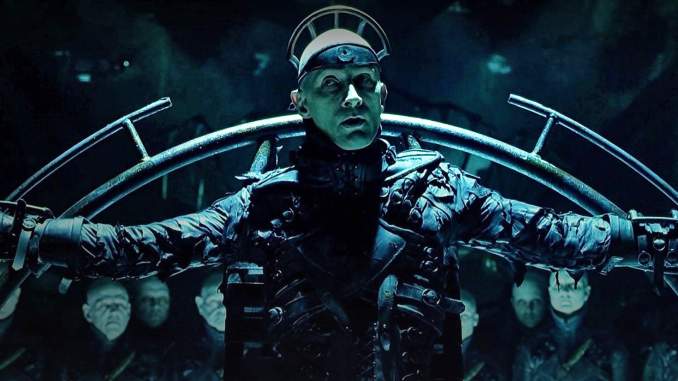
Dark City Embodied the Paranoid Thrillers of Its Time While Looking Like Nothing Else
Right before the final reveal in Dark City, Rufus Sewell’s amnesiac protagonist and William Hurt’s overwhelmed detective demand answers from Kiefer Sutherland’s character, a hobbled quisling who we learn was tortured into submission to the sinister powers behind the eponymous setting. Sutherland doesn’t have all the answers: Who knows where we’re from or what we could’ve been, he wonders.
The “mood” of action thrillers in the days of superhero tentpoles is being systematically stripped away in favor of deep and ever-salable lore. It’s too bad, because it defines movies from earlier eras: The paranoid plots of the ’50s and ’60s are about Communism and McCarthyist authoritarianism and nuclear annihilation; the ’70s had its political conspiracies, the ’80s the despair over Reaganism and deindustrialization. It’s that paranoid mood, more than the black-on-black getups and sci-fi conspiracy plots, that mark some of the action thrillers of the time when Dark City came out: Actioners like The Matrix and Equilibrium, trippy stuff like Strange Days and eXistenZ, even popular anime of the mid-to-late ‘90s like Ghost in the Shell and Big O, all featured some creepy idea of memories or emotions being false, fabricated or repressed by the powers that be. Most of them occurred over a neo-noir backdrop (or an explicitly cyberpunk one, a genre that owes as much to noir as the Western owes to samurai flicks).
Dark City isn’t the first of these, but coming out in 1998, it solidified the overwhelmed angst of the time into a singular film, one of the last to be made during a time in Hollywood’s special effects history when a movie could look exactly as distorted and off-kilter as it does. Its ending beam-struggle battle belongs in at least the all-time Top 20.
In Dark City, a man awakens in a bathtub in a grody hotel room with no memory of who he is or why he’s there, bleeding from a pinprick in his forehead. He learns that his name is John Murdoch (Sewell), and that he’s been at the hotel for three weeks. He has an estranged wife (Jennifer Connelly), a furtive psychiatrist (Sutherland) and pockets full of news clippings about all the murdered sex workers in town. Murdoch is not the only one who believes he may be their murderer: The fastidious and lonely Detective Bumstead (Hurt) is on Murdoch’s tail. But Murdoch is also hunted by pale, bald, creeper weirdos in black trenchcoats and fedoras with psychic powers. In his desperate flight from them, Murdoch discovers he too can move things with his mind, something his pursuers call “tuning.”
As Murdoch flees and tries to piece together his shattered identity from the contents of a lost wallet and the local phone book, other harrowing details begin to emerge: At midnight (or is it noon?) the entire city comes to a halt and everyone, except for him, falls asleep. Like Santa’s elves, the trenchcoated Strangers move throughout the city, amplifying their reality-warping powers through machinery to bend the city into new shapes and to rearrange its people, right down to their memories and identities. Murdoch is one of the unlucky few who finds himself awake during this urban rezoning, and one strange action sequence involves him evading the Strangers while the world around him bends and twists to frustrate his escapes—staircases lengthening, doors opening to nowhere, buildings expanding to crush the hapless people caught in between.
That’s one layer of Dark City, visually the most interesting but also the easiest to explain. The character work in between those scenes, which often feels as if it’s disconnected, is where the real ideas of the film percolate. Connelly is trying to figure out if her husband really is a killer. Hurt finds himself unable to ignore the mounting evidence that something is off about this world where the sun never rises and his partner has been driven to mad paranoid rantings. Sutherland finds moments to whisper to them all even as he tries to conceal his own part in the conspiracy (and conceal his rebellion from the conspirators).
Those parts of Dark City feel disjointed, but also like the essential ingredient: Connelly singing at the club (she’s lip-syncing), Hurt deadpanning his way through rueful one-liners as he follows the trail of dead bodies, Sutherland knowingly smirking at and fearfully recoiling from the Strangers and the people caught in their web.
Dark City’s main sin is that it overexplains itself when it would be more intriguing if it left more of its intricate details unspoken. Why is Murdoch awake? The broken former detective Walenski (Colin Friels) explains to Murdoch that he, too, is one of the humans who has ceased to fall under the sleeping spell of their alien captors—as the Strangers move people around every night, Schreber injects them with new memories, swapping around the identities of everyone for the purposes of observing them like lab rats.
What is the purpose behind this sadistic social experiment? When Murdoch and Bumstead finally catch up to Schreber, he explains that the Strangers are aliens with a gestalt consciousness, and they’re seeking some key to human inpiduality to stave off a coming extinction. (Inpiduality, and specifically heterogeneity, is key in so many of the plots of these movies: Even in Ghost in the Shell, Kusanagi explains to a new member of the unit who doesn’t feel he fits the usual profile that this was the point of bringing him on: “Overspecialization leads to death.”)
Why did the Strangers create this darkened world, a mishmash of architectures and eras, a kind of machine-learning version of an American metropolis? As one of the captive Strangers explains to a knife-wielding Murdoch who has him dead to rights, they blended the history of humanity to come up with something that worked. It’s overly tidy when it would benefit from being more obtuse.
Inpiduality is the key, and it is more than the sum of a person’s memories. With some help, Murdoch wins in the end, subverting the Strangers’ reality-warping machine and using it to fuck up their program. He does battle with the baldest and creepiest of the Strangers and seizes control of the reality they’ve built. One dude wins against the system.
The ‘90s sucked. Wage stagnation, the decline of gainful employment and an increasingly stifling social order designed to bury us all in bureaucracy all got worse. The sense that the best regular people could hope for was a job and a life designed to enervate them is probably the defining feature of the art that spoke to Generation X’s outsiders. In films like Dark City, the sense that nobody is even aware of what’s being done to them is the real source of the anxiety. A popular girl at my high school once told me that if our schools had their way, we’d all grow up to be robots, and she was right.
Dark City, like that other all-black-clad conspiracy film that came out the very next year, The Matrix, depends on the premise that They are out to get you, and They’ll stop at nothing to take control of everything: Your job, your family, your body, the thoughts in your head. Director Alex Proyas told the story with a lot of disturbing flourishes, but the most interesting parts aren’t all that gnarly or gruesome at all: Even when you take the hotel manager out of the lobby and randomly assign him to a newsstand, he still believes that there’s “no time off for good behavior.” How much remains of the struggling lower-class family after Schreber and the Strangers grant them an overnight promotion to snide socialites? Probably more than we’d like to admit.
I wish Proyas had been more interested in those bits, but they still stand out prominently in a paranoid, oppressive film with a look that you’ll never forget.
Kenneth Lowe’s capacity for inpiduality is what makes him different from them. You can follow him on Twitter and read more at his blog.









![[VIDEO] Gelagat Che Ta Tunggu Aaisyah Bersiap Cetus Perhatian Ramai!-“Tengok Penampilan, Tercampaklah Mak Hang!” [VIDEO] Gelagat Che Ta Tunggu Aaisyah Bersiap Cetus Perhatian Ramai!-“Tengok Penampilan, Tercampaklah Mak Hang!”](https://i0.wp.com/murai.my/wp-content/uploads/2024/04/25DCA8CF-C629-4DCA-8597-2CA8819D9297.jpg?resize=150%2C150&ssl=1)














![[VIDEO] Reaksi Tunku Azizah Sambut Birthday Anakanda Tengku Puteri Jihan, Raih Perhatian Ramai! [VIDEO] Reaksi Tunku Azizah Sambut Birthday Anakanda Tengku Puteri Jihan, Raih Perhatian Ramai!](https://i0.wp.com/murai.my/wp-content/uploads/2024/04/Untitled-design-27.jpg?fit=300%2C300&ssl=1)










![[VIDEO] Nadhir Nasar Sambut Birthday Tengku Ameera Cetus Perhatian Ramai”- Nak Kena Bersaing Dengan Kerabat Pulak, Hmm” [VIDEO] Nadhir Nasar Sambut Birthday Tengku Ameera Cetus Perhatian Ramai”- Nak Kena Bersaing Dengan Kerabat Pulak, Hmm”](https://i0.wp.com/murai.my/wp-content/uploads/2024/04/D3415DF6-2464-4794-880F-841EB898C969.jpg?w=768&ssl=1)































